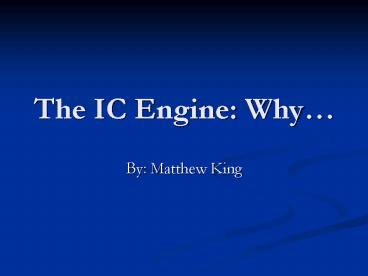The IC Engine: Why - PowerPoint PPT Presentation
1 / 14
Title:
The IC Engine: Why
Description:
The internal combustion engine was first conceived and developed in the late 1800's ... a system open to the transfer of enthalpy, mass, work, and heat, the net energy ... – PowerPoint PPT presentation
Number of Views:393
Avg rating:3.0/5.0
Title: The IC Engine: Why
1
The IC Engine Why
- By Matthew King
2
Outline
- A Short History
- Background
- Why
- How do we compare engines and their cycles?
3
History
- The internal combustion engine was first
conceived and developed in the late 1800s - The man who is considered the inventor of the
modern IC engine and the founder of the industry
is pictured to the right.Nikolaus Otto
(1832-1891). - Otto developed a four-stroke engine in 1876, most
often referred to as a Spark Ignition, since a
spark is needed to ignite the fuel air mixture.
4
History
- The impact on society is quite obvious, all most
all travel and transportation is powered by the
IC engine trains, automobiles, airplanes are
just a few. - The IC engine largely replaced the steam engine
at the turn of the century (1900s) - Another important cycle is the Diesel cycle
developed by Rudolph Diesel in 1897. This cycle
is also known as a compression ignition engine.
5
Background on IC Engines
- An internal combustion is defined as an engine
in which the chemical energy of the fuel is
released inside the engine and used directly for
mechanical work, as opposed to an external
combustion engine in which a separate combustor
is used to burn the fuel.1 - IC engines can deliver power in the range from
0.01 kW to 20x103 kW, depending on their
displacement.2
6
Background on the Otto Cycle
- The Otto Cycle has four basic steps or strokes
- 1. An intake stroke that draws a combustible
mixture of fuel and air into the cylinder - 2. A compression stroke with the valves closed
which raises the temperature of the mixture. A
spark ignites the mixture towards the end of this
stroke. - 3. An expansion or power stroke. Resulting from
combustion. - 4. An Exhaust stroke the pushes the burned
contents out of the cylinder. - To the right is an idealized representation of
the Otto cycle on a PV diagram. - http//www.rawbw.com/xmwang/javappl/ottoCyc.html
7
Why
- The Otto cycle IC engine has remained
fundamentally unchanged, besides slight
improvements, for over 100 years. Its popularity
has continually increased because - Relatively low cost
- Favorable power to weight ratio
- High Efficiency
- Relative simple and robust operating
characteristics - Improvements are mainly lower emissions and
higher fuel efficiency
8
Comparing Engines.
- mep work done per unit displacement volume
- Or average pressure that results in the same
amount of indicated or brake work produced by the
engine - Scales out effect of engine size
- Two useful types imep and bmep
- imep indicated mean effective pressure
- -the net work per unit displacement volume done
by the gas during compression and expansion - bmep brake mean effective pressure
- -the external shaft work per unit volume done by
the engine
9
BMEP
- Based on torque
(4 stroke)
(2 stroke)
10
Compare
- Brake specific fuel consumption (bsfc)
- Measure of engine efficiency
- They are in fact inversely related, so a lower
bsfc means a better engine - Often used over thermal efficiency because an
accepted universal definition of thermal
efficiency does not exist
11
bsfc
- bsfc is the fuel flow rate divided by the brake
power - We can also derive the brake thermal efficiency
if we give an energy to the fuel called heat of
combustion or, qc
12
Compare
- Volumetric Efficiency, ev
- The mass of fuel and air inducted into the
cylinder divided by the mass that would occupy
the displaced volume at the density ?i in the
intake manifold - Note its a mass ratio and for a 4 stroke engine
- For a direct injection engine
13
Other comparisons
- First law analysis- energy conservation
- For a system open to the transfer of enthalpy,
mass, work, and heat, the net energy crossing the
control surface is stored into or depleted from
the control volume - Second Law Analysis entropy conservation
- This approach takes into account the
irreversibility that occurs in each process - Another outcome of this analysis is the
development of the usefulness of each type of
energy (exergy)
14
References
- 1. Internal Combustion Engines, Colin R.
Ferguson, John Wiley Sons, 2001 - 2. Engines An Introduction, John L. Lumley,
Cambridge University Press, 1999































